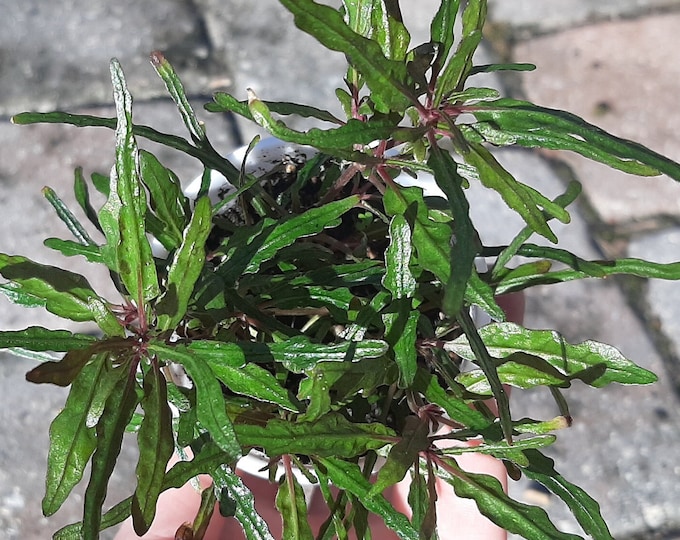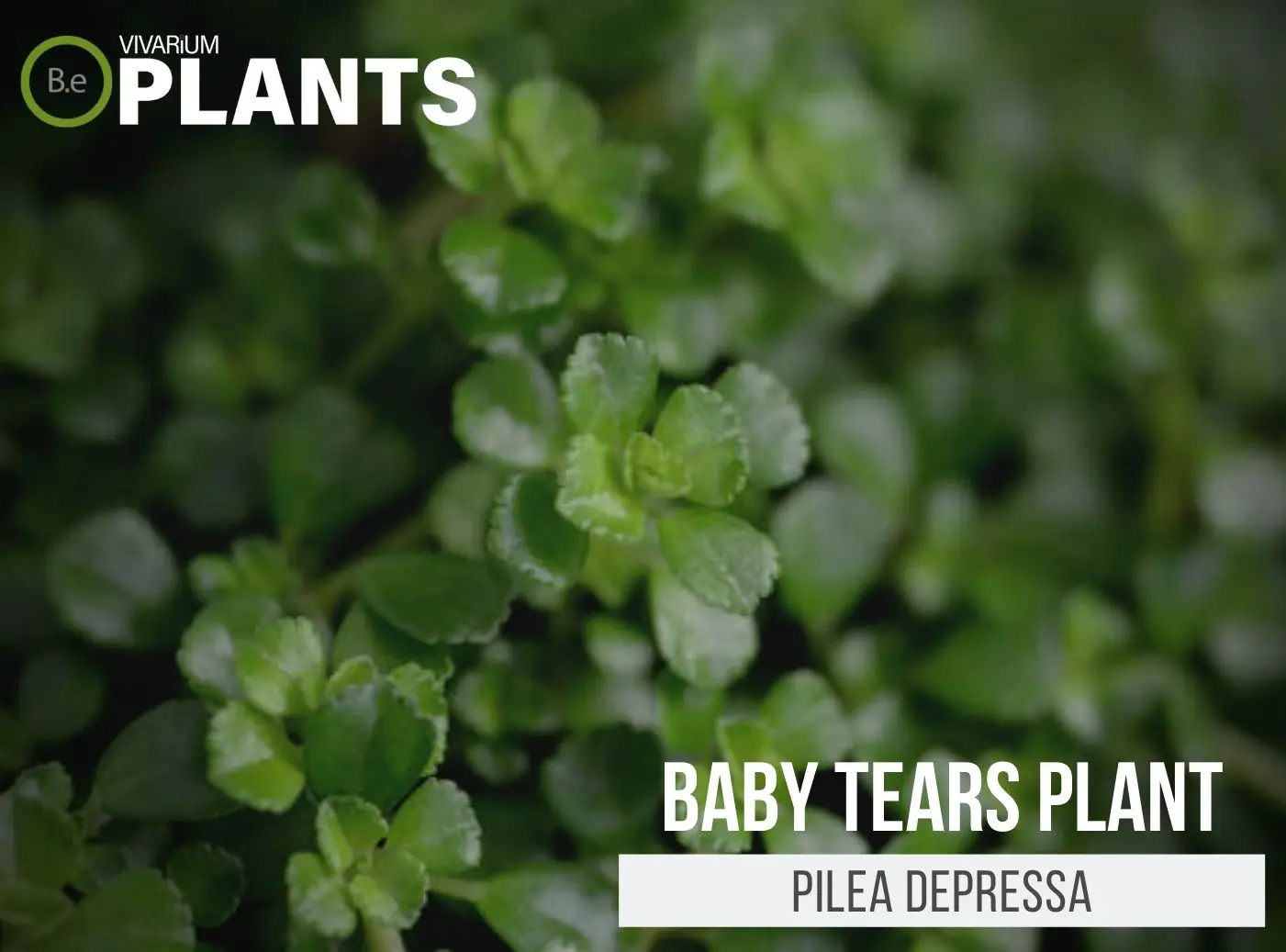Hemigraphis repanda, also known as Dragon’s Tongue, is an emerging micro-acre tropical plant that is becoming popular among vivariums.
This plant has a few distinct characteristics to it that make it perfect for adding more life to a hobbyist’s enclosure.
Whether an enclosure is full of animals or not, this plant is an excellent low-maintenance accent that is great for aquascaping and habitat aesthetics.
| Quick Stats: | |
|---|---|
| Scientific Name | Hemigraphis repanda |
| Common Name | Dragon’s tongue, Purple Foliage |
| Family Name | Acanthaceae |
| Habitat | Tropics |
| Temperature | 65°F to 80°F |
| Height | 12 Inches |
| pH | 6.0 to 7.0 |
| Lighting | Bright, Indirect |
Table Of Contents:
ToggleWhat Is Dragon’s Tongue?
Dragon’s Tongue is a species of plant that originates from the tropics of Indonesia, Thailand, and Malaysia.
This plant is becoming very popular in the vivarium and aquarium hobby because of its adaptability and low-maintenance requirements.
Furthermore, it is often described as having vibrant-colored foliage and broad leaves that contrast other plants in its vicinity.


Dragon’s Tongue Facts
Hemigraphis repanda is also known as Dragon’s Tongue due to its coloration and oval-shaped leaves.
This plant is relatively small and grows no taller than a height of 12 Inches.
Its leaves are a purple to deep pink color but can vary darker and brighter depending on its environment.
This plant is a slow grower, so it’s great for filling in spaces that are bare in appearance and does not require constant pruning.
Description
Hemigraphis is recognizable due to its vibrant foliage and wide leaves.
This plant has a trailing growth habit, so it tends to be used as a filler in areas with empty spaces or underneath taller plants.
The leaves on this plant are usually widened when they are hydrated and shrink when they appear to be lacking in water or nutrients.
This plant’s leaves are oval in shape and usually arranged in pairs when growing on the stem.
Habitat
Dragon’s Tongue originates from the tropics of Southeast Asia, so it’s commonly found in moist, humid environments.
This plant is found at the base of trees and often on the forest floor.
When kept in a terrarium, its preferred temperature is a range of 65°F to 80°F, and prefers temples on the warmer side.
PH Preference
Hemigraphis has a broad pH range as it can do well in acidic or alkaline soil with a range of 6.0 to 7.0 being ideal.
In the tropics, this plant is found in between bark and moss, indicating lovely acidic or just neutral soil.
Vivarium Type
There is no set type of enclosure that the Dragon’s Tongue must be grown in. In fact, they can do very well in a variety of vivarium types.
One of the most important things to keep in mind when choosing the appropriate enclosure is the amount of space available.
In addition, Hemigraphis repanda should also be provided with tropical and moist terrain areas.
Here are recommended vivariums it will do well in:
- Paludariums – Half aquatic/ half terrain-based enclosure.
- Terrariums – Fully terrain-based enclosures with little to no aquatic features.
Vivarium Placement
This plant is mainly grown as a foreground or midground plant providing a contrasting color to the foliage around it.
This plant works well when added to taller hardscapes because it can help to trap water and maintain moisture for a longer period of time.
Dragon’s Tongue can also be placed in the background of an enclosure to add a pop of color and some texture variety.
Substrate
Hemigraphis does very well in a soil-based terrarium substrate with a medium-to-high amount of organic material.
This plant adapts well to different textures of substrate but prefers a medium- to high-density substrate.
The vibrant plant should not be planted in sand or akadama as it will not be able to work itself into the substrate and grow properly.
Lighting
Dragon’s Tongue prefers to be in the medium to low range when it comes to terrarium lighting.
This plant is perfect for vivariums looking to establish medium to high light without it being terribly bright.
However, due to its bright foliage, it needs some direct sunlight to achieve its fullest potential.
Aim for cooler temperature bulbs that will mimic overcast days or lightly shaded areas.
Buy Dragon’s Tongue Plant
When it comes to buying a Dragon’s Tongue, there are a few things to keep in mind.
Making sure that the plant being bought is healthy is essential for its success in a vivarium.
Vegetation that is already in poor conditions, will have a very hard time adjusting to new environments.
In addition, always check the foliage closely for yellowing, wilting, black spots, or any signs of damage.
Pay close attention and look for any pests or fungal diseases. Inspect both sides of the leaves to avoid missing any red flags.
Click the image below to find out more about the current price and other relative info about this plant:


Dragon’s Tongue Plant Care and Propagation
Dragon’s Tongue is extremely easy to care for due to its low-maintenance requirements.
This plant does not need to be pruned much as it grows in a way that allows it to stay at manageable heights.
Unfortunately, this plant does not propagate easily so it is recommended to pick up rooted cuttings from reliable vendors.
How to grow
This plant is quite easy to grow but not so easy to propagate. When sourcing Hemigraphis repanda, try to pick up a pre-rooted piece from a reputable vendor.
Place the plant in the substrate lightly and it should take a few weeks for it to attach its roots.
Once it has taken root and started to grow, keep up with regular watering so that it can remain hydrated and healthy.
Watering
Hemigraphis prefers moist substrates with occasional watering one to two times a week.
In general, allow the media to dry out in between waterings but don’t let it get bone dry.
If it appears to be drying out rapidly, try increasing the humidity around the enclosure. If there is a massive leaf curl, too much water will be the culprit.
Plants Similar To Dragon’s Tongue Plant
Adding diversity to an enclosure is key to an aesthetically pleasing setup.
Try mixing up the look of your vivarium with different flora that can easily co-exist in the same types of environment.
Furthermore, if for some reason you find Hemigraphis repanda hard to acquire or would like to consider something similar to this plant…
Here are some other tropical plants you might find may do well with or in place of Dragon’s Tongue:
Conclusion
Hemigraphis repanda is an excellent plant to have in a vivarium when trying to create a vibrant display.
This plant looks great when used as a contrast to other plants with lighter foliage.
With its relatively low-maintenance needs and bright foliage, this plant is an ideal addition to any vivarium to add a natural-looking vibrant contrast.
Frequently Asked Questions
The Dragon‘s Tongue plant (Hemigraphis repanda) makes an excellent addition to any indoor garden due to its vibrant colors, hardiness, and easy–to–care instructions. To keep your Dragon’s Tongue happy and healthy, follow these simple instructions:
1. Place your plant in a spot that gets partial to light shade, as direct sun can scald the delicate leaves.
2. Water your Dragon’s Tongue moderately, allowing the soil to dry out between waterings.
3. Feed the plant with a balanced liquid houseplant fertilizer every two weeks during spring and summer. (BONUS)
4. Prune off any discolored or damaged leaves to keep your cooler temperature bulbs looking clean and healthy.
With just a little attention, your Dragon’s Tongue plant can give you years of enjoyment.
Yes, dragon‘s tongue prefers a humid environment. The ideal humidty for this plant is between 40-70%.
No, a dragon’s tongue plant is not poisonous to cats. However, ingestion of any parts of the plant may cause gastrointestinal upset, so cats should not be allowed to eat the plant.



